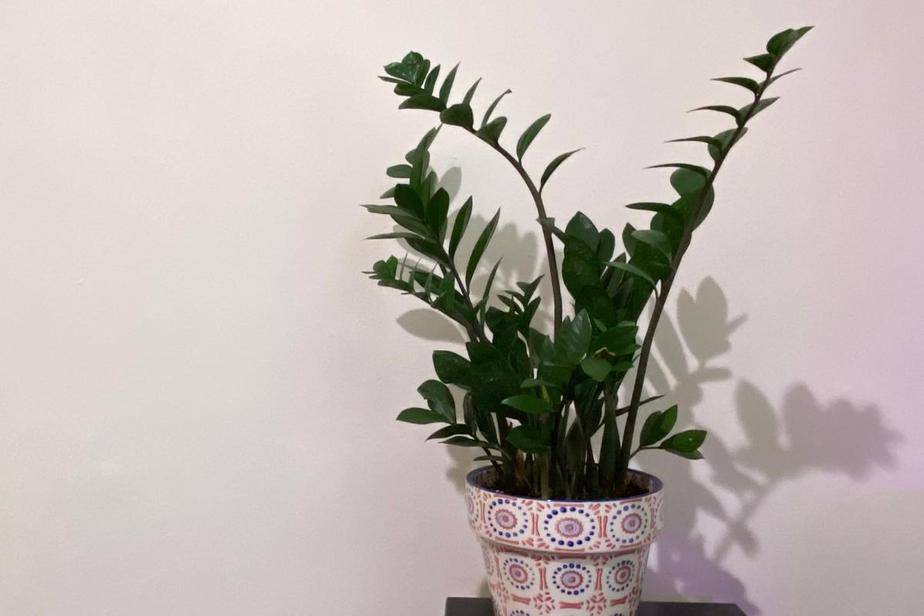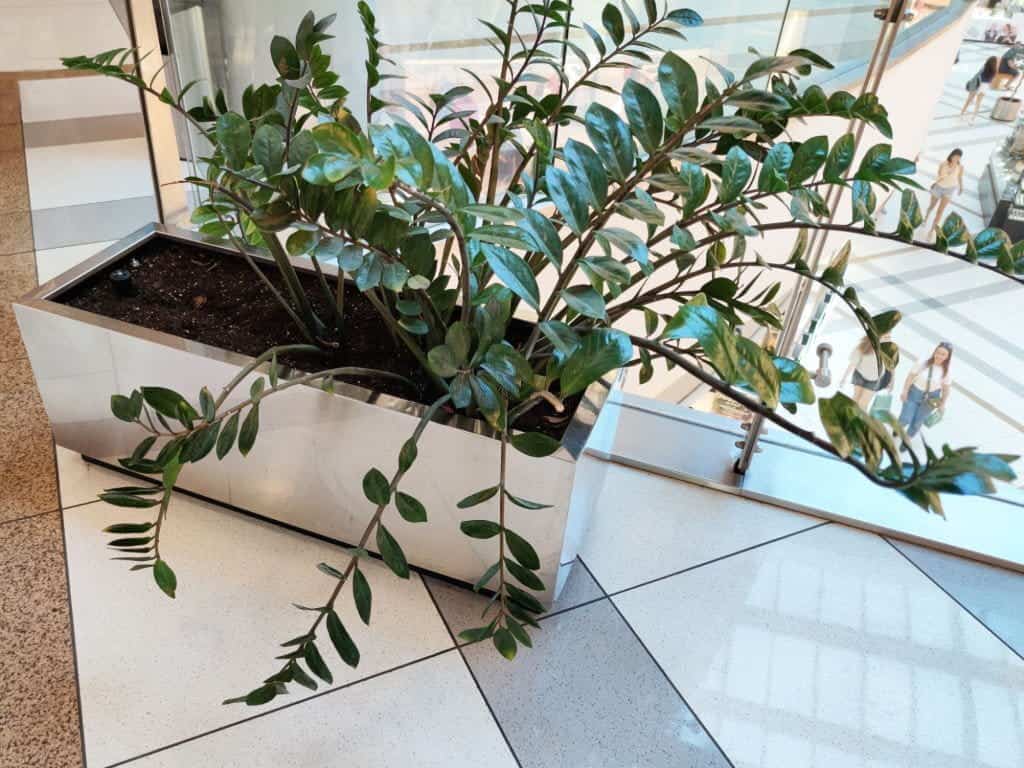Zamioculcas zamiifolia abbreviated ZZ plant is a plant native to the rainforests of Africa. This plant likes indirect sunlight and has a strong vitality. So they are often grown in homes or offices.
However, one of the phenomena that you may often encounter in the process of taking care of ZZ plants is thin stems. ZZ plant leggy & leaning? Yes, this plant can grow long, broken, and weak if the care conditions are not suitable.
What is the cause of this phenomenon? How to fix this problem? Let’s find out more information in the article below.
ZZ Plant Leggy & Leaning? Here is why
Before figuring out the cause and remedy of the phenomenon of a thin body, we need to learn about its theory and its negative effects.
What is ZZ plant leggy & leaning?
ZZ plant has a slower growth rate than common plants. So, if the ZZ plant grows too fast, it will cause the stem and leaves to become longer and thinner.

A mistake many gardeners often make is over-stimulating the growth of this plant. Growing too fast will not be able to meet the standards for diameter and stiffness of the trunk.
Fast-growing stems are thin, long, and often curved. The stems will bend and grow in different directions instead of straight. The negative effect of this phenomenon will cause the body of the ZZ plant to become thin, curved, and weak.
In addition, the ZZ plant does not have enough energy and hardiness, the flowering process will be slow and the number of flowers will not be up to the standard.
The number of flowers will be less than regular ZZ plants with sturdy and healthy stems.
What causes the ZZ plant to be thin and long?
There are many causes for the thin and long stem of the ZZ plant such as light, improper watering, fertilizing, and damage from pests and diseases.
1. Lack of light
Many people love the ZZ plant for its large and sturdy stems, neatness, and slow growth rate. However, low light conditions are the main reason for this plant’s thin and long stem.
Usually, this plant is known to favor indirect light and does not tolerate direct sunlight. Therefore, a common mistake that many people make is not providing enough light for them.
The low light condition is that direct or indirect light from the sun never reaches the ZZ plant. If you can provide artificial light then this plant can grow normally.
However, if you plant them in a place with dim or no light, the ZZ plant’s stem will be thin and long. Lack of light will prevent photosynthesis for plants and energy for healthy growth.
Therefore, the phenomenon of long, thin stems and few leaves is a sign of a severe lack of light. The long and thin body will make the body soft and weak and lead to bending.
The ZZ plant will be bent and tilted on all sides to find where there is sunlight. This not only makes the pot unsightly, but the vitality of the tree is also seriously affected.
2. Watering too little
Many people love to grow ZZ plants in the home or office because they can withstand drought and lack of water for a long time.
ZZ plant cannot store water like cacti, so it still needs to be watered 1-2 times per month. Without water, the stem of the ZZ plant will be thin, long, and bent due to the weakness of the stem.
To ensure the best growth for this plant, you need to check the moisture in the soil before watering. If the ground is about 1-2 inches dry, you need to water deeply and slowly to let the water seep into the soil. Signs of a lack of water are yellow, dry, and curled leaves.
In particular, misting only helps to slightly improve humidity, but cannot replace water. The root system of the ZZ plant needs to receive enough water to nourish the stem and leaves. Misting only helps to clean leaves and moisture, but cannot add water when the plant lacks water.
3. Watering too much
Too much watering is also the cause of the ZZ plant’s stem being long and thin. This plant has a system with tubers capable of storing water and using it for about 1 month.
So normally you only need to water 1-2 times a month under the right conditions. For areas with high humidity, heavy rainfall, or winter, you should only water when the ground is dry.
Excessive watering causes the soil to become waterlogged, and poorly drained leading to root and stem rot. When the root system is rotted due to waterlogging, the stem of the ZZ plant will be tilted and bent, even broken.
Excessive watering also creates favorable conditions for fungi to grow and destroy the stem. Signs of excess water are water overflowing the ground, sticky soil, yellow leaves, and soft, mushy, bent, and tilted stems.

4. Moving from one pot to another
ZZ plants can also get thin and long when you switch from one pot to another suddenly. At the same time, changes in location and temperature will also cause this phenomenon.
When changing habitat, the roots of the ZZ plant will have to work harder to adapt to new living conditions. This process can cause the roots to receive fewer nutrients, water, and oxygen than usual. So the trunk will also be affected and become longer and thinner.
ZZ plant is also difficult to grow strong and has large, sturdy stems in cold temperatures. This plant’s preferred temperature is 65 to 75 degrees F, and ideal humidity is 40-50%.
So if you move these plants from pot to pot or change the temperature, you need to give them time to get used to it.
Read also: When To Repot Zz Plant
5. Damaged root system
Damage to the root system is an important cause of the plant not receiving enough nutrients, water, and oxygen. As a result, the trunk will become thin, long, and bent on the sides.
Damaged roots can result from many causes such as waterlogging, fungus, and pests. If you find the ground has a layer of humus, a rotten smell, and soft stems and leaves, the root system is rotten.
You need to gently remove the ZZ plant from the pot, and inspect and remove the rotten roots and stems. You should only keep the roots and stems healthy so that they continue to grow in the future.
6. Improper fertilization
ZZ plant is a plant that can live in low nutrient conditions. So, if you fertilize more than 2 times in 1 year, this plant may not grow well.
You should only fertilize once every 6 months and at a dose appropriate to the size of this plant.
However, if you fertilize too little, the ZZ plant’s stem will not have enough nutrients to grow. So they will become thin, long, and bent.
Nutrient ingredients such as phosphorus, nitrogen, and potassium should be used in a uniform ratio of 20-20-20. Fertilizers with a higher nitrogen content than potassium and phosphorus will cause the leaves of the ZZ plant to burn and the stems to droop.
Conclusion
The stem of the ZZ plant can be long or thin for a variety of reasons. Some of the main causes in the process of caring for this plant are low light, watering, fertilizing, and pests.
To avoid this, you need to provide enough light for the ZZ plant such as indirect or artificial light. Fertilize every 6 months with uniform levels of nutrients from nitrogen, potassium, and phosphorus.
In addition, proper watering will also help this plant become healthier. To find out more useful information, you can visit the ZZ plant catalog here.